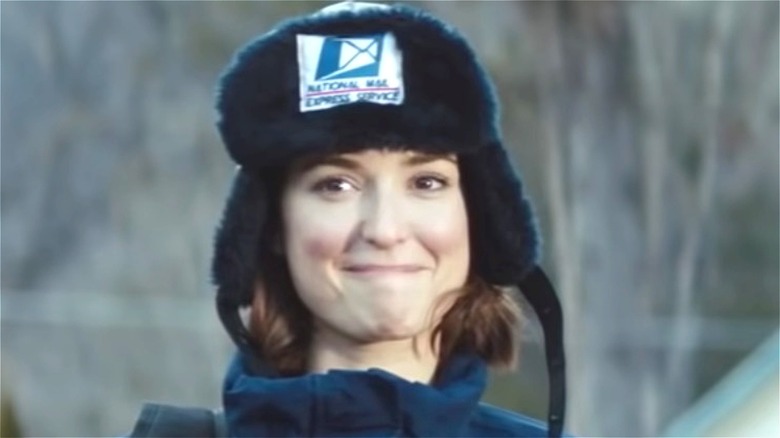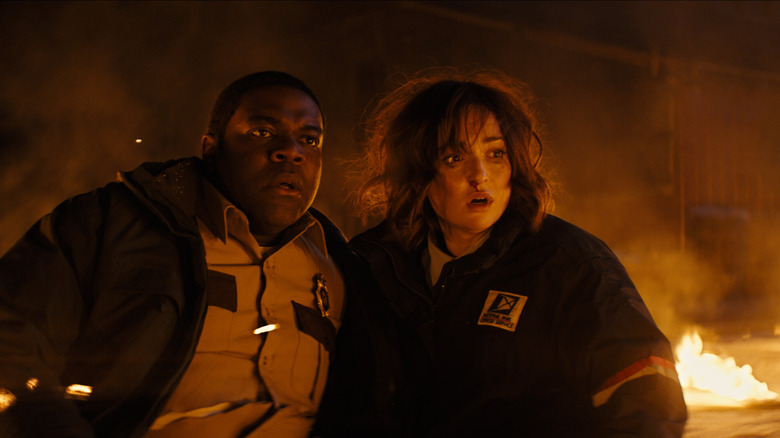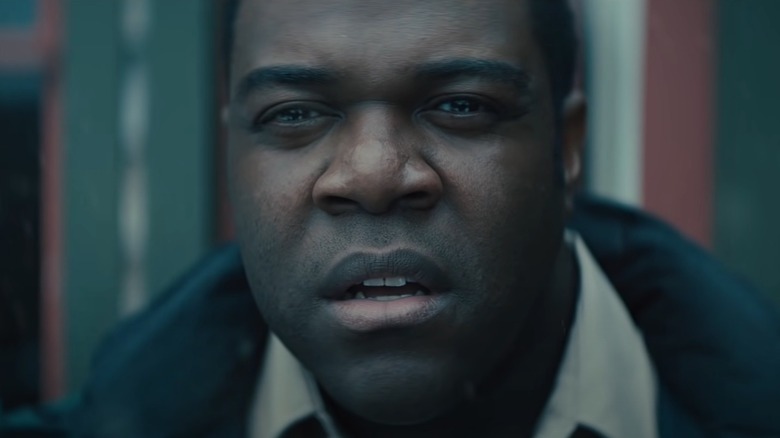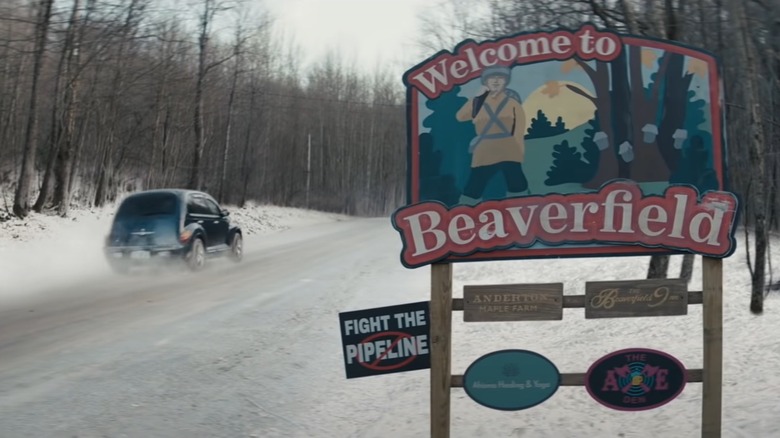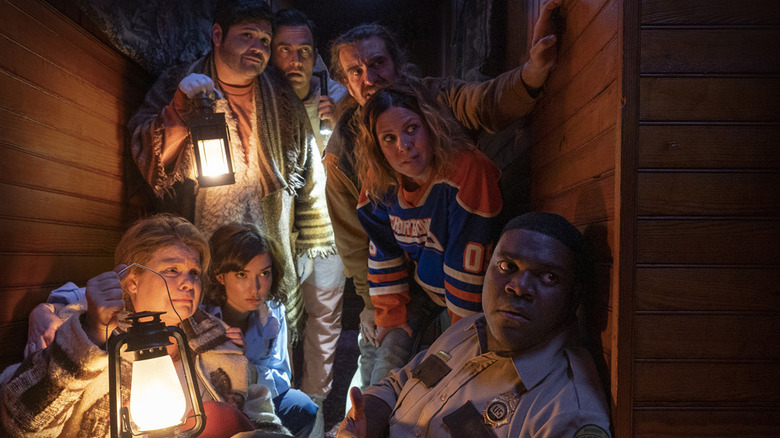The Ending Of Werewolves Within Explained
Before there was a little game called "Among Us," there was the party game "Mafia" — also known as "Werewolf." Everyone sits around in a circle, assigned roles either as villagers or as the threatening werewolf (or mafia member). The werewolf secretly kills a player, then the players attempt to deduce who is the killer, often with much arguing.
In 2016, Ubisoft brought this game to VR with "Werewolves Within." No longer was the setting your living room, but a cartoonish, spooky old town. No longer did you have to control your facial expressions to lie to your friends, because everyone playing had cartoon villager personas. Still, there was arguing.
Now, it's a movie: "Werewolves Within," the horror-comedy, brings the action to modern times in a small, isolated Vermont town in the middle of winter. Park ranger Finn Wheeler (Sam Richardson of "Veep") comes to Beaverfield amidst a clash over a proposed gas pipeline. Half the town wants it, while half oppose it, says his friendly guide, postal worker Cecily (Milana Vayntrub). However, when a snowstorm, power outage, and a missing dog bring everyone together in the local inn, a dead body and the threat of a werewolf exacerbate tensions to the point of violence.
By the end, few of the ensemble are left alive, and Finn must face off with the werewolf: Cecily.
Whodunnit? Cecily is the werewolf
As it turns out, it is the postal person who goes postal. Sarcastic, funny Cecily, who charms audiences and Finn alike within the first minutes of the movie, is a werewolf. The werewolf.
Finn learns this in the movie's climax as it echoes their early bonding scene: They're in the closed arcade bar, but now Finn's throwing axes at Cecily, who's wolfed out and no longer asking if she can kiss him. "The Sign" by Ace of Base plays again, to comedic effect. The sign is clear: She's trying to kill him.
After a string of misdirection and confusion, we learn that Cecily has been eating people all around Vermont before coming to Beaverfield. Midland Gas executive Parker (Wayne Duvall) has been hunting her this whole time, though he didn't realize she was the werewolf. Oddly enough, Cecily wasn't the one who killed most of the people in the movie, as they quickly turned on each other, but she sowed the chaos.
First, she killed the inn owner's husband, Mailman Dave (Patrick M. Walsh), and took his job just a month ago. That gave her the opportunity to further isolate the town by hoarding packages of essential snowplow mechanical parts before taking out the generators. She ate the dog Cha-Chi and then bit off Pete's (Michael Chernus) hand because he'd been trying to inappropriately touch her. To draw attention away from herself, she planted both Cha-Chi's collar and the knife that mangled the generators on other characters.
Her plan was to round up the bodies and freeze them to have a long-lasting supply of food. However, she is foiled by Finn and survivalist Emerson Flint (Glenn Fleshler) before being killed by inn owner Jeanine (Catherine Curtin) with a crossbow inside the bar.
Finn accepts himself as a nice guy
We first meet park ranger Finn in his car, listening to an audiobook about how to "man up." He clearly feels he needs to change from his nice, non-confrontational personality, and is often told so. By the end, however, he gains confidence in himself and takes on confrontation, all while sticking to his guns about being nice.
"I like to play characters who are nice. The spectrum of niceness is oftentimes overlooked," actor Sam Richardson told Inverse about Finn. "You have your spectrum of evil. This guy is a mean guy, this guy is an a**hole, this guy is a murderer — all of those things. And then there's just this guy's nice." Richardson told CBR that Finn's niceness is holding him back a bit, but his real conflict comes when he's suddenly in charge of the crisis. He doesn't want to be in charge, but he eventually rises to the occasion.
Finn would probably be friends with the unendingly optimistic Ted Lasso, but he had far less luck spreading his message of being good with the residents of Beaverfield than Ted did in his soccer community. Finn does reach one person, though: the terrifying lone wolf Emerson Flint, who saves him from Cecily as an act of neighborly goodness.
In the end, Finn survives the ordeal with only Emerson and Jeanine. What becomes of the pipeline plan is unclear, but Finn now has the confidence to push back against it if another Midland Gas representative comes to town.
It's a terrible day in the neighborhood
"Werewolves Within" begins with a quote by Mister Rogers, the kind childrens' TV host, that says, "Listening is where love begins: listening to ourselves and then to our neighbors." No one in the movie embodies that quote more than the protagonist, Finn, who attempts to unite the town in the face of adversity. And yet, they're all so divided over the gas pipeline that they end up killing each other.
There's a reason the movie title is plural; while only one werewolf actually lives in Beaverfield, everyone has a little pent up werewolfiness in themselves. No one comes out of the movie not having hurt someone. "The allegory and theme of it all is, we all have violent, dreadful thoughts every once in a while when pushed to our limits," director Josh Ruben told Den of Geek. "Even Sam's character, as wonderful a protagonist as he is, he's pushed to his limit, as well. Every character could have reason to be a werewolf, hence the wonderful mystery of it all." However, while everyone flirted with the wolf inside, the only characters who survived the movie were the ones showing kindness.
It's impossible to separate this neighborly love, or lack thereof, from the blatant political bent to the characters that's clearly inspired by current-day America. In an interview with SlashFilm, Ruben said, "The boiling point comes when the isolated and those who grew up with tunnel vision are forced to look at themselves and question their own ideologies, philosophies, and existential state. And you become either someone who gives themselves over to new ideas or you're suddenly an animal in a cage, swinging and breaking out and adhering violently to those ideals." And they definitely violently adhered to their ideals in this movie, invoking a message about political divides killing us.
The film's environmental theme slips through the cracks
Still, "Werewolves Within" falls a little flat on the environmental themes that are so crucial to the premise. The resident scientist, Dr. Jane Ellis (Rebecca Henderson), never really says her piece against the pipeline and the movie is obviously missing indigenous voices on the matter. In the end, there's no resolution to whether the pipeline is built or not. The movie seems to side with the environmentalists, but only in Finn's non-confrontational way.
"I thought it was a very interesting take with a very clear environmental issue," actor Sam Richardson told Inverse. "Some people have something to gain from it. Some people have something to lose, which is true to the world ... There's a reason people keep on sapping the life of the earth. It's because you get something out of it. It's a short-term gain with long-term effects." Well, in "Werewolves Within," the pro pipeline people didn't even live to see those short term gains because of how ravenous they were to acquire them.
